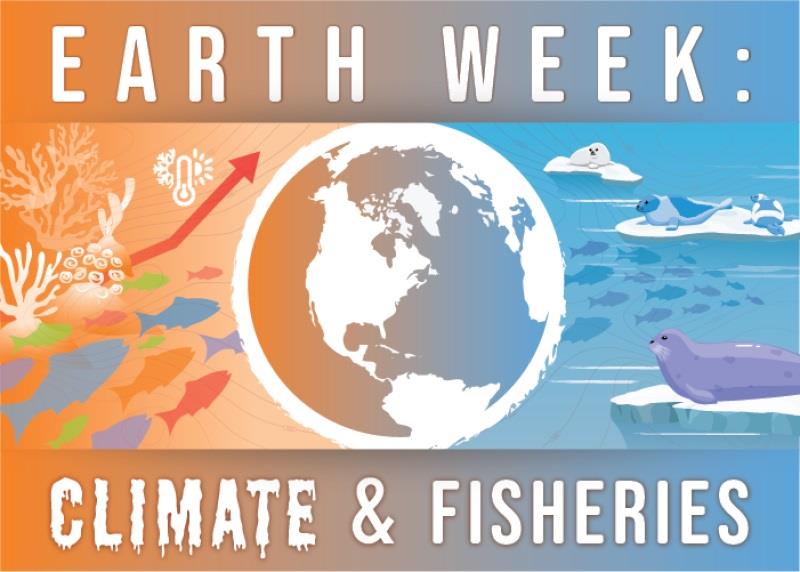
Earth Week: Climate and Fisheries
by NOAA Fisheries 22 Apr 2022 22:26 UTC
22 April 2022

Earth Week: Climate and Fisheries © NOAA Fisheries
Earth Day is April 22, a time to honor and celebrate our incredible planet. It is also a time to recognize the serious challenges ahead, especially in the face of a changing climate. We know climate change is already impacting our ocean and coastal resources.
This week, we are taking a look at the ways NOAA Fisheries scientists are using the best available science to prepare for and respond to changing climate and ocean conditions.
Explore the features below to see how our scientists are studying the impacts and providing best-in-class data and information for a Climate-Ready Nation.
Adapting to the future: Two NOAA scientists discuss new global report on climate change
NOAA Fisheries podcaster John Sheehan talks with Dr. Kirstin Holsman and Dr. Libby Jewett, two of the authors of the Intergovernmental Panel on Climate Change report. They share insights on some of the very real challenges of climate change, as well some actionable information.
Listen to the podcast
Video: U.S. Fisheries face climate challenges
Climate change is affecting where fish live, what they eat, and how many of them survive in the ocean. Watch the video below to learn more about what is changing and what we are doing to understand the effects of climate change on fish stocks.
Learn more about climate and fisheries
New global forecasts of marine heatwaves foretell ecological and economic impacts
The forecasts could help fishing fleets, ocean managers, and coastal communities anticipate the effects of marine heatwaves.
Learn more about new global forecasts of marine heatwaves
New state-of-art-tool for mapping marine species distribution information
This portal provides easy access to information on the distribution of over 800 marine fish and invertebrate species! The new portal enables users to view, download, and dynamically explore and visualize data and information on species distributions. Specifically, users can select a species of interest and view both changes in its spatial distribution on a map as well as time-series graphs of key distribution indicators (e.g., average latitude and depth). Our goal for the portal is to increase the ease by which information on species distribution changes can be accessed, explored, understood and used to inform decision making.
Launch the distribution mapping and analysis portal
Join us for NOAA Fisheries' Earth Week 2022
A message from Assistant Administrator Janet Coit highlighting NOAA Fisheries' work to build a more resilient nation in the face of climate change.
Read Janet's leadership message on Earth Week 2022
Checking in with NOAA Fisheries climate scientists
"Dive Into the Issue": Visualizing climate change with Melissa Karp
Explore how NOAA Fisheries' new, interactive fisheries data portal shows how specific marine species' locations have shifted over time, which may be in response to climate change. This tool can help us better understand and respond to these changes.
Visualizing climate change with new fisheries data portal
"Climate Change at the Water's Edge": Understanding the impacts of black mangroves on juvenile shrimp
Climate change is transforming estuaries along the Gulf Coast. Learn how these changes may impact shrimp populations with two NOAA Fisheries shrimp experts.
Understanding impacts of black mangroves on juvenile shrimp
"An era of surprises": Studying climate change and salmon with Nate Mantua
NOAA Fisheries scientist Nate Mantua discusses why he started studying salmon as well as how climate change and anchovies are threatening salmon on the West Coast.
Studying climate change and salmon
"A Better Chance for Resilience": Using hungry fish to conserve coral reefs
NOAA Fisheries scientist Tye Kindinger explains how identifying the best seaweed-grazing fish in the Pacific Islands region can help fight against seaweed overgrowth and promote recovery of distressed coral reefs.
Using hungry fish to conserve coral reefs
More features
Video: Our climate and our fisheries
Changes in the earth's atmosphere—due to human activities—have led to warming of the planet. Watch the video below to learn what climate change really means for our planet.
Progress report on NOAA Fisheries climate science strategy
NOAA Fisheries recently released a five year progress report on its Climate Science Strategy. The report highlights the goals, activities and accomplishments of the seven climate Regional Action Plans and national efforts from 2016-2020. Continuing to meet the goals of the Climate Science Strategy will require enhanced resources to support data collection and management efforts, IT infrastructure and modeling capacity, and fostering strong communication between scientists, managers, and stakeholders.
Learn more about the Five Year Progress Report on NOAA Fisheries Climate Science Strategy